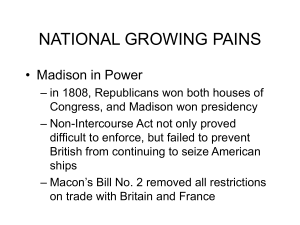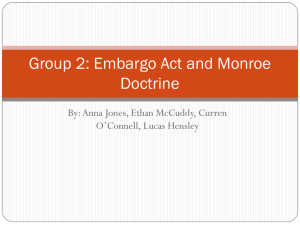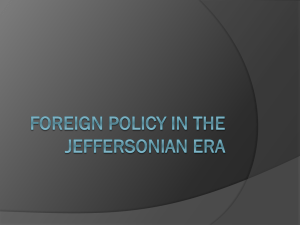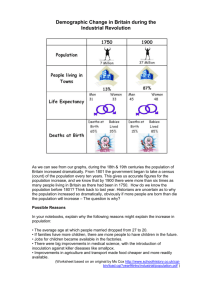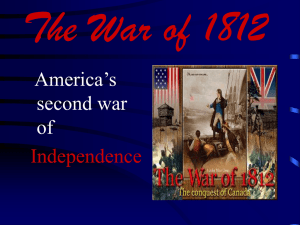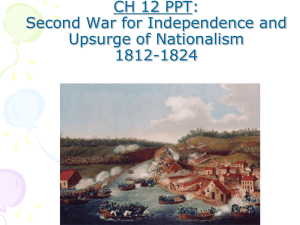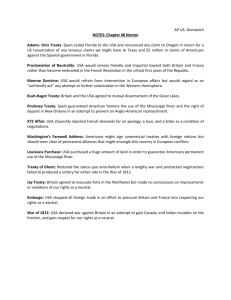Chapter 7 Overview
advertisement
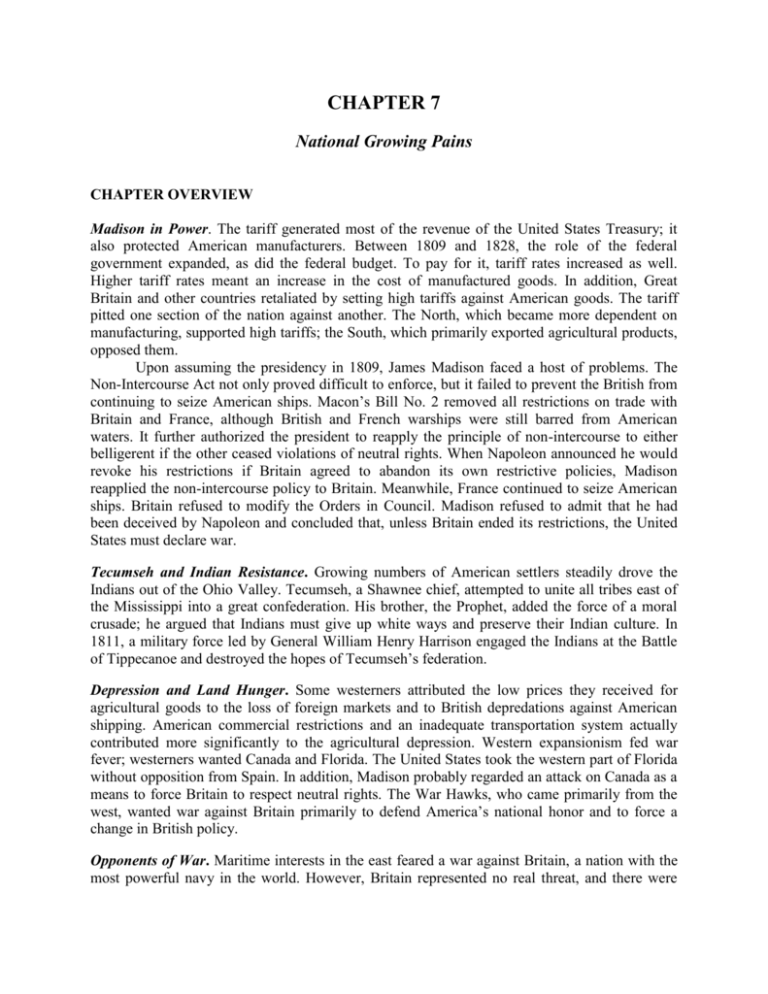
CHAPTER 7 National Growing Pains CHAPTER OVERVIEW Madison in Power. The tariff generated most of the revenue of the United States Treasury; it also protected American manufacturers. Between 1809 and 1828, the role of the federal government expanded, as did the federal budget. To pay for it, tariff rates increased as well. Higher tariff rates meant an increase in the cost of manufactured goods. In addition, Great Britain and other countries retaliated by setting high tariffs against American goods. The tariff pitted one section of the nation against another. The North, which became more dependent on manufacturing, supported high tariffs; the South, which primarily exported agricultural products, opposed them. Upon assuming the presidency in 1809, James Madison faced a host of problems. The Non-Intercourse Act not only proved difficult to enforce, but it failed to prevent the British from continuing to seize American ships. Macon’s Bill No. 2 removed all restrictions on trade with Britain and France, although British and French warships were still barred from American waters. It further authorized the president to reapply the principle of non-intercourse to either belligerent if the other ceased violations of neutral rights. When Napoleon announced he would revoke his restrictions if Britain agreed to abandon its own restrictive policies, Madison reapplied the non-intercourse policy to Britain. Meanwhile, France continued to seize American ships. Britain refused to modify the Orders in Council. Madison refused to admit that he had been deceived by Napoleon and concluded that, unless Britain ended its restrictions, the United States must declare war. Tecumseh and Indian Resistance. Growing numbers of American settlers steadily drove the Indians out of the Ohio Valley. Tecumseh, a Shawnee chief, attempted to unite all tribes east of the Mississippi into a great confederation. His brother, the Prophet, added the force of a moral crusade; he argued that Indians must give up white ways and preserve their Indian culture. In 1811, a military force led by General William Henry Harrison engaged the Indians at the Battle of Tippecanoe and destroyed the hopes of Tecumseh’s federation. Depression and Land Hunger. Some westerners attributed the low prices they received for agricultural goods to the loss of foreign markets and to British depredations against American shipping. American commercial restrictions and an inadequate transportation system actually contributed more significantly to the agricultural depression. Western expansionism fed war fever; westerners wanted Canada and Florida. The United States took the western part of Florida without opposition from Spain. In addition, Madison probably regarded an attack on Canada as a means to force Britain to respect neutral rights. The War Hawks, who came primarily from the west, wanted war against Britain primarily to defend America’s national honor and to force a change in British policy. Opponents of War. Maritime interests in the east feared a war against Britain, a nation with the most powerful navy in the world. However, Britain represented no real threat, and there were many strong cultural ties between the two countries. On the other hand, Napoleon posed a genuine and serious threat to the United States, and going to war with Britain would aid Napoleon. Moreover, by 1812, conditions in England made a change in British maritime policy likely. The growing effectiveness of Napoleon’s Continental System caused a depression in Britain, and British manufacturers, who blamed hard times on the loss of American markets, urged the repeal of the Orders in Council. Gradually, the British government moved to suspend the Orders, but not until Congress had declared war on Great Britain in 1812. The War of 1812. The War of 1812 was poorly planned and managed. Despite a few successes at sea, the U.S. Navy could not effectively challenge Britain’s mastery of the Atlantic. Canada appeared to be Britain’s weak spot, but an American invasion failed because of poor leadership and the unwillingness of some American militiamen to leave their own soil. Soon Americans were fighting to keep the British from taking American territory. Captain Oliver Hazard Perry defeated the British fleet and gained control of Lake Erie. This made British control of Detroit untenable, and when they fell back, Harrison defeated the British at Thames River. Another attempt to capture Canada failed, however, and the British captured Fort Niagara and burned Buffalo. Britain Assumes the Offensive. The war against Napoleon occupied the British until 1814. After Napoleon’s defeat, the British put more effort into the war with America. The British undertook a three-pronged attack, but they were scarcely more effective than the Americans when they assumed the offensive. The central British force did take Washington and burn most public buildings; however, the attack on Washington constituted the only British success. When they moved up the Chesapeake, American forces stopped them at Baltimore. “The Star Spangled Banner.” An American civilian, Francis Scott Key, observed the bombardment of Fort McHenry from the deck of a British ship, where he was being held prisoner. When he saw the American flag still flying over the fort the next morning, he dashed off the words to the “Star-Spangled Banner,” which was later set to music and eventually became the national anthem. The burning of Washington shocked many Americans, and thousands came forward to enlist. The British advance from the north was checked by a much smaller force of Americans at Plattsburg. The Treaty of Ghent. In 1814, the British and Americans met at Ghent to discuss terms for peace. The British prolonged negotiations in the hope that their offensive would give them the upper hand. News of the British defeat at Plattsburg, however, forced the British to modify their demands. They eventually agreed to American demands for the status quo ante bellum. Negotiators signed the Treaty of Ghent on December 24, 1814. The Hartford Convention. News of the treaty had not yet reached America when a group of New England Federalists met to protest the war and plan for a convention to revise the Constitution. Their opposition to the war had made them unpopular in the rest of the country, which in turn encouraged extremists in New England to talk of secession. However, moderate Federalists controlled the Hartford Convention. Their resolutions argued that states had a right to interpose their authority to protect themselves from violations of the Constitution. They also proposed a series of amendments to the Constitution. News of the Treaty of Ghent discredited Federalists, who had predicted a British victory. The Battle of New Orleans and the End of the War. News of the Treaty of Ghent failed to arrive in time to prevent the Battle of New Orleans. The British attack on New Orleans was part of their three-prong offensive. Americans, commanded by General Andrew Jackson, successfully withstood the British assault and inflicted heavy casualties on the British while suffering only minor losses themselves. America’s ability to hold off the British in the War of 1812 convinced European powers that the United States and its republican form of government were there to stay. The war cost the United States relatively few casualties and little economic loss (except for shipping interests). Among the big losers were Native Americans. Anglo-American Rapprochement. After the War of 1812, Britain and the United States negotiated peaceful solutions to several old problems. American trade had become more important to the British economy, and in 1815 the two countries signed a commercial agreement ending discriminatory duties and making other adjustments favorable to trade. In 1817, in the Rush-Bagot Agreement, the two countries agreed to demilitarize the Great Lakes. The following year, a joint Anglo-American commission settled the disputed boundary between the United States and Canada by designating the 49th parallel as the northern boundary of the Louisiana Territory from the Lake of the Woods to the Rocky Mountains. They also agreed to the joint control of the Oregon country for ten years. The Transcontinental Treaty. Jackson’s pursuit of Indians into Spanish Florida and his capture of two Spanish forts raised Spanish fears that America would eventually seize all of Florida. Spain was even more concerned about the security of its holdings in northern Mexico and was ready to give up Florida in exchange for an agreement protecting its Mexican empire. However, in the Transcontinental Treaty of 1819, Spain had to accept a boundary to the Louisiana Territory that followed the Sabine, Red, and Arkansas rivers to the Continental Divide and the 42nd parallel to the Pacific. The United States obtained Florida for $5 million, to be paid to Americans with claims against Spain. The Monroe Doctrine. Fears of Russian expansion in the Western Hemisphere prompted Monroe and his secretary of state, John Quincy Adams, to warn: “The American continents are no longer subjects for any new European colonial establishments.” Russia agreed to abandon territorial claims south of 54 degrees, 40 minutes and to remove restrictions on foreign shipping. A greater threat came when several European powers decided to try to restore Spain’s empire. Neither the British nor the Americans wanted to see a restoration of the Spanish empire. Britain, however, had no desire to recognize the new revolutionary republics in South America, in spite of a growing trade with these countries. America had already recognized them. Monroe rejected a British proposal for a joint declaration and included a statement of American policy in his message to Congress in 1823. The United States would not interfere with existing European colonies in North or South America and would avoid involvement in European affairs. However, any attempt to extend European control to countries that had won their independence would be considered hostile to the United States. The Monroe Doctrine may be seen as the final stage of American independence. The Era of Good Feelings. The political factionalism of earlier days diminished during Monroe’s presidency, which came to be known as the “Era of Good Feelings.” The country was at peace and prosperous. It has been said that the harmony of the era was largely superficial. However, the people of the period had good reasons for believing that their era was harmonious. Jeffersonians had come to accept most of Hamilton’s economic policies. The Jeffersonian balance between individual liberty and responsible government had survived both bad management and war; in doing so, it established its legitimacy even to the opposition. When political divisions reappeared, they did not grow out of old controversies. Rather, new issues emerged out of the growth of the country. New Sectional Issues. The War of 1812 and the depression that struck the country in 1819 shaped many of the controversies of the Era of Good Feelings. The panic of 1819 strengthened the position of protectionists, who argued that American industry needed protection from foreign competition. The protectionists included small manufacturers, unemployed workers, and farmers (who depended on the workers as consumers of agricultural products). With the exception of shipping interests, the North favored protectionism. The South initially favored protectionism as a means to foster national economic self-sufficiency. Eventually, however, the South rejected protectionism on the grounds that tariffs increased the price of imports and hampered the export of cotton and tobacco. The charter of the First Bank of the United States was not renewed when it expired in 1811, mainly because of opposition from state banks. Many new state banks were created after 1811, and most recklessly overextended credit. After the British raid on Washington created a panic, all banks outside New England suspended specie payments. A second Bank of the United States was established in 1816, but, unlike the first Bank, it was poorly managed and irresponsibly created credit. The depression of 1819 hit the Bank as hard as it hit many state banks. In response, the Bank pursued a policy of strict curtailment in order to restore its financial standing. As a result, the Bank reached a new low in public favor. Regional divisions were less distinct on the Bank issue than on the tariff. Easy credit policies of the banks led to a boom in land sales. However, agricultural expansion in America and the resumption of agricultural production in Europe after the Napoleonic Wars resulted in falling prices. As prices fell, many western debtors faced ruin. Westerners wanted cheap land, while the North and South regarded the public domain as a national asset to be converted into as much money as possible. Northern manufacturers also worried that cheap western land would draw off surplus labor from the east and force up wages. Southern planters feared competition from southwestern cotton. Although slavery became the most divisive sectional issue, it caused remarkably little conflict in national politics before 1819. Congress abolished the African slave trade in 1808 with little controversy. New free and slave states were added to the Union in equal numbers, thus maintaining the balance in the Senate. The cotton boom led southerners to defend the institution more aggressively, which irritated many northerners, but most people regarded slavery as a local issue. The West tended to support the South’s position. Southwestern slave states naturally supported slavery; in addition, the Northwest was also sympathetic, partly because it sold much of its produce to southern plantations and partly because many settlers in the area came from slave states. New Leaders. New leaders emerged after the War of 1812 to replace the Revolutionary generation. John Quincy Adams emerged as the best-known northern leader of the early 1820s. Adams began his career as a Federalist but became a Republican. An ardent nationalist, he supported the Louisiana Purchase and internal improvements. Like most New Englanders, he opposed slavery. Daniel Webster, although basically a nationalist, reflected the interests of his native New England. A professional politician, Martin Van Buren avoided taking positions if he could avoid it. He expressed no clear opinions on such major issues as slavery or the tariff. The most prominent southern leader, William H. Crawford of Georgia, served in the Senate and as Monroe’s secretary of the treasury. Although many of his contemporaries considered him no more than a spoilsman, he administered the Treasury Department exceptionally well. The other outstanding southern leader, John C. Calhoun of South Carolina, took a strong nationalist position on all issues of the day. Although devoted to the South and its institutions, he took a broad view of political affairs. Henry Clay of Kentucky was the most prominent western leader. Clay’s “American System” reflected his gift for seeing national needs from a broad perspective. He advocated federal support for internal improvements and a protective tariff. Although himself a slave owner, he opposed slavery on principle and favored colonization. The Missouri Compromise. Missouri’s request for admission as a slave state touched off a serious political controversy. In voting that split along sectional lines, the House added the Tallmadge Amendment to the Missouri Enabling Act. The Tallmadge Amendment prohibited the further introduction of slavery into Missouri and provided that all slaves born in Missouri after statehood should be freed at age twenty-five. The Senate defeated the amendment. The debate did not turn on the morality of slavery. Northerners objected to adding new slave states because these states would be overrepresented in Congress under the Three-fifths Compromise. Since the debate concerned political influence rather than the morality of slavery, the situation lent itself to compromise. Missouri entered as a slave state, and its admission was balanced by the admission of Maine as a free state. To prevent further conflict, Congress adopted a proposal to prohibit slavery in the Louisiana Territory north of 36 degrees, 30 minutes. The Election of 1824. Politics continued to divide along sectional lines, although no issue divided the country as deeply as slavery. Politicians who aspired to the presidency could not afford to alienate any section by taking extreme positions on divisive issues. By 1824, the old party system had broken down. The Federalists had disappeared as a national party, and factional disputes plagued the Jeffersonians. No candidate won a majority of the electoral college in a bitter contest that attracted little public interest. In the House of Representatives, Clay threw his support to John Quincy Adams, who became the next president. J.Q. Adams as President. Adams took a Hamiltonian view and sought to promote projects beneficial to the national interest. He proposed a vast program of internal improvements as well as aid to manufacturing and agriculture. A Jeffersonian nationalist would have had difficulty gaining acceptance of these proposals; with his Federalist background, Adams had no chance. An inept politician, Adams’s public utterances tended to be bumbling and cumbersome. Calhoun’s “Exposition and Protest.” A new tariff in 1828 set high duties on manufactured goods and agricultural products. Calhoun believed that the tariff would impoverish the South. In response, he wrote the “South Carolina Exposition and Protest,” an essay repudiating the nationalist philosophy he had previously espoused and defending the right of a state to nullify an act of Congress. The Meaning of Sectionalism. The sectional issues that strained the ties between people of different regions were products of powerful forces, such as growth and prosperity, and actually bound the sections together. Other forces unifying the nation were patriotism and commitment to the American experiment in government.
